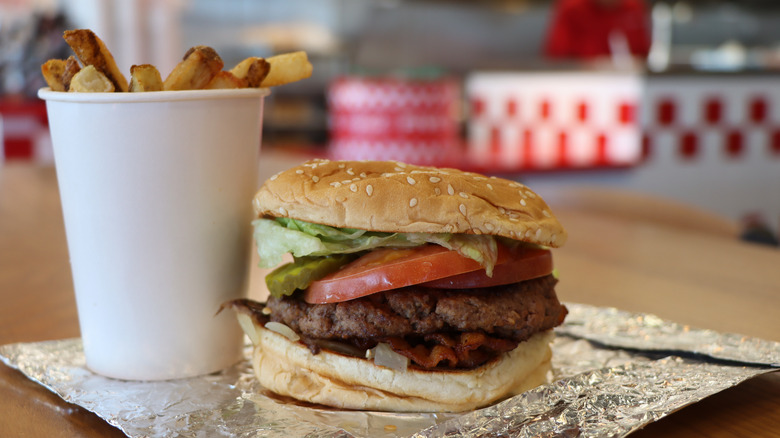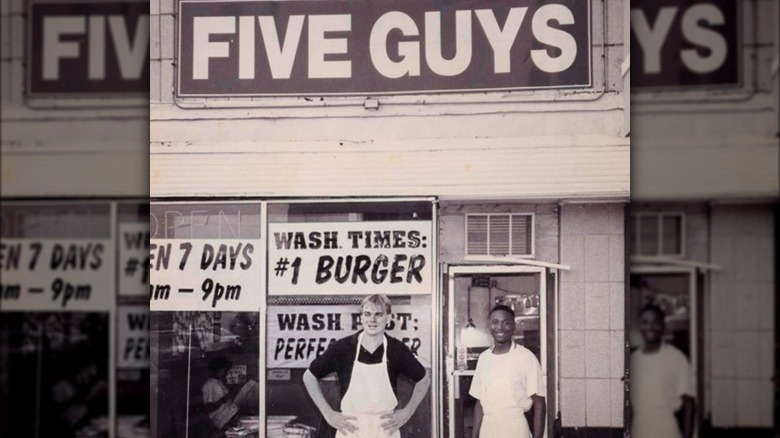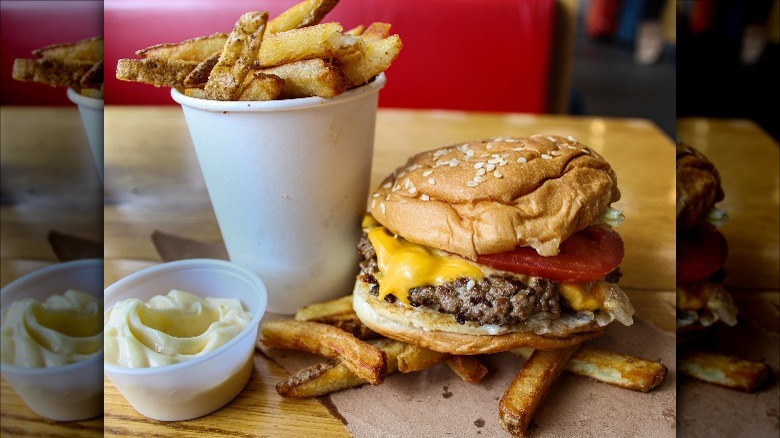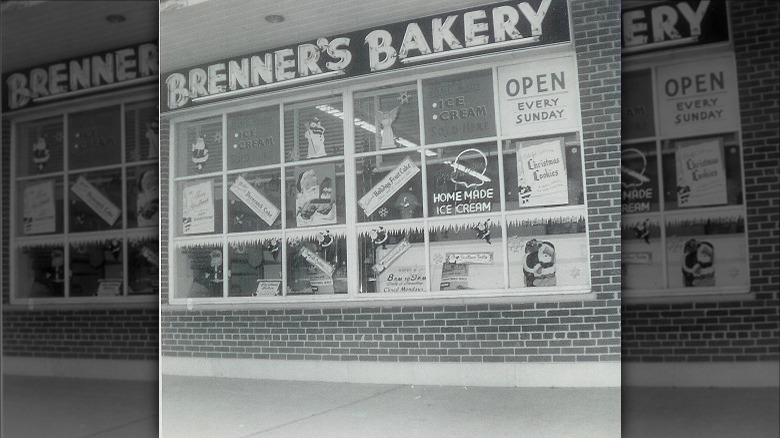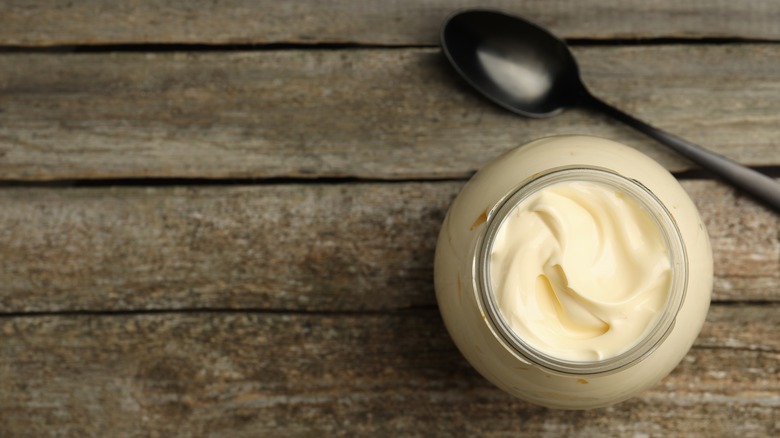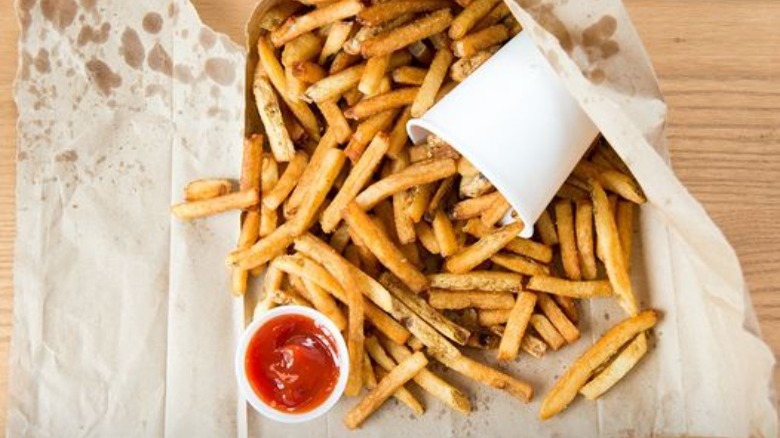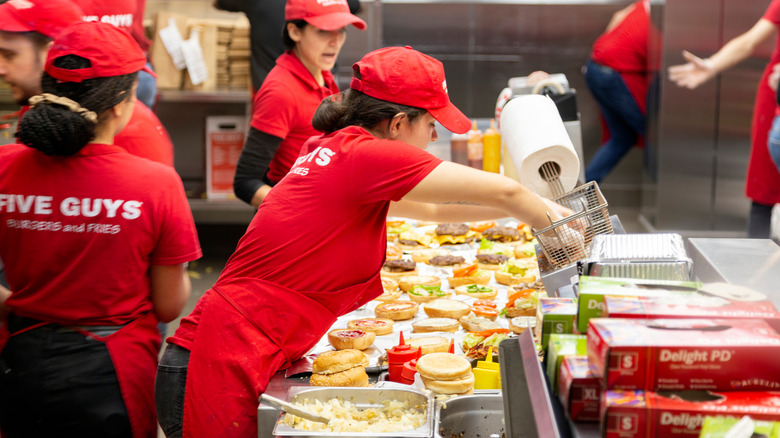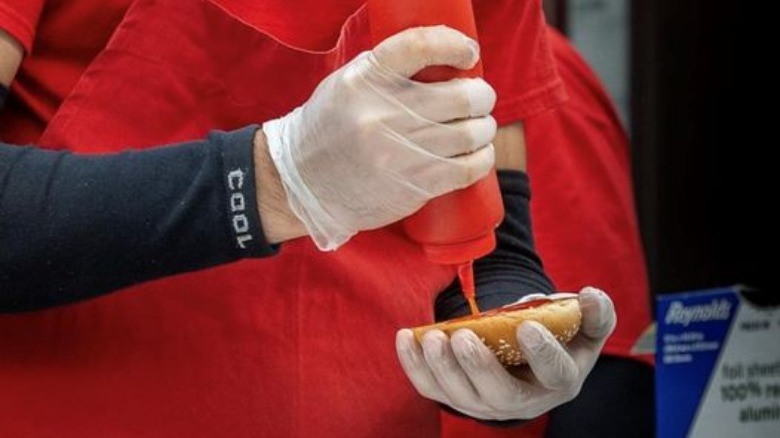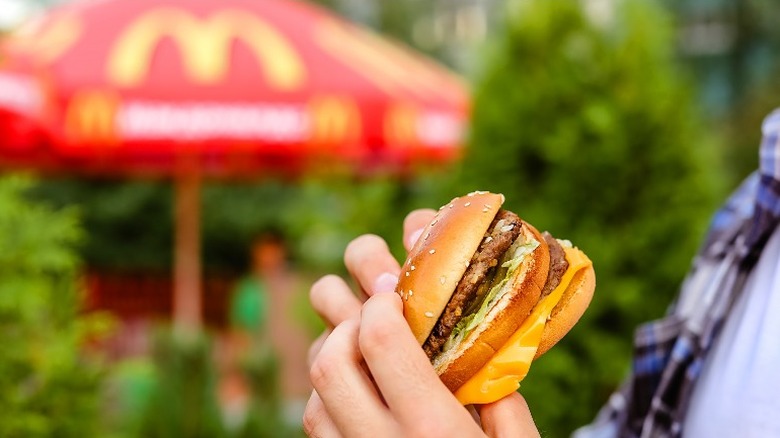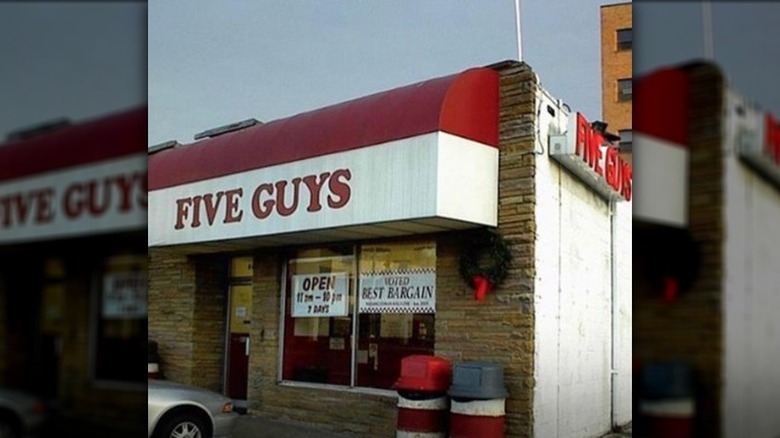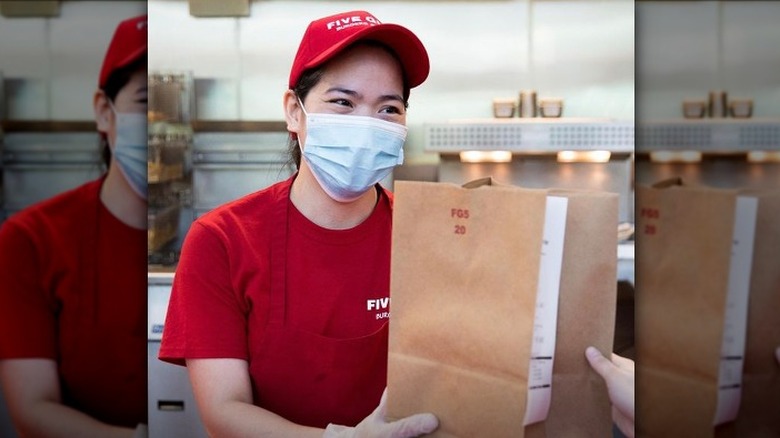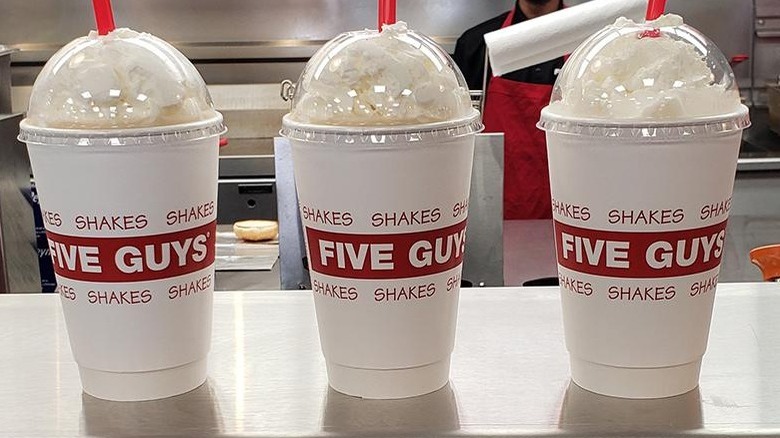What It Was Really Like To Eat At The First Five Guys
A Five Guys run today would include free peanuts, unlimited burger toppings, and an extra scoop of fries with your order, but what was it like at the very first Five Guys store? For those who are curious about the past, here's a piece of trivia: when Five Guys opened its doors for the first time in 1986, the 'five guys' referred to a different set of guys as it does today. You see, the founder, Jerry Murrell, had only four sons — Jim, Matt, Chad, and Ben — at the time. They were the Five Guys then. But then a fifth son, Tyler, came along, and Jerry took a backseat (via Inc.).
In the first year, Ben would have been too small to work, and Tyler wasn't even born. Today, Ben is in charge of the franchises and Tyler runs the bakeries (via Yahoo! Life). The chain has come a long way from one that didn't sell any milkshakes, bought pickles from BJ's for its burgers, and used big burgers instead of the two thin patties that have become its trademark (via NBC News). If you were able to time travel to the location where it all began, here's how it would have been.
The first store was in a shopping center that's now demolished
When Five Guys opened its first store in Arlington, Virginia, it was almost as if it didn't want people to notice. Not only did it not advertise, but its launch was also quieter than the sizzling of a burger. The store was in a corner of a run-down shopping center, as the founder Jerry Murrell told motivational speaker Mike Luzio in an episode of 52 American Success Stories. Turns out, the Westmont Shopping Center was the only place would lease space to him, as he told Arlington Now. "Seriously, we were brand new, without any restaurant experience, selling burgers and fries," he said.
But also, Jerry specifically wanted a less-conspicuous place. He said, "We liked that it was tucked back and hard to get to. We knew that if we could survive and grow there, then we might really have something." And because it was in the middle of nowhere, it was relatively inexpensive, he said. All in all, the low-risk venture was perfect for Jerry, who was working as a financial planner and had failed in at least three other businesses including oil, water, and real estate before he decided to try his hand at burgers and fries, as he told NPR.
The first store was a roaring hit. However, there's no way to visit it. In 2019, Westmont Shopping Center was demolished to be redeveloped into an apartment building (via Arlington Virginia website).
There was no place to sit and eat
At Five Guys, the décor is so basic that the only things that probably stand out for customers are the sacks of potatoes laid out on the floors and the staff crafting burgers in the chain's open kitchens. The first store, founder Jerry Murrell told NPR, didn't even have chairs and tables for customers to sit and eat. It was a cramped stand-up-only place. As Matt Murrell, Jerry's second son, told Forbes, "It [the store] was in the middle of nowhere, there was no parking and no place for customers to sit and eat."
Today, Five Guys is among the top 30 locations in the US for a first date (via Detroit Free Press). We guess for some, there's nothing more romantic than sharing an order of Cajun fries.
But the first Five Guys didn't have any space for romance to brew. He had bought the place for a mere $35,000 and assembled all the equipment from junk. To compare, close to $150,000 was raised to set up the second store, Jerry told NPR. The second store also had no seating; it wasn't until the early 2000s that the chain decided to allow people to dine in (via Washington Business Journal).
The menu had only burgers and fries
The first Five Guys store sold two items: burgers and fries (via Five Guys). Why? Those were the only two things that the founder Jerry Murrell knew how to cook, as he told NPR. But it was not just his limited culinary skills that pushed him to create the minimalist eatery. He was intrigued by how Thrasher's French Fries attracted a beeline of customers when there were about 20 or so other shops selling fries on the Ocean City Boardwalk. He was also inspired by an entrepreneur in his hometown in Michigan who ran a successful business selling nothing but hamburgers. Thrasher's and the Michigan hamburger seller gave him the idea to start a business concept that would combine fries and burgers.
Over the years, Jerry and his sons, while continuing to keep burgers and fries as their main focus, also experimented with different items — out of which only a few items like hot dogs, veggie burgers, and grilled cheese sandwiches managed to earn permanent spots in the menu (via Forbes). A few others such as chicken breast sandwiches, Virginia-baked ham, and coffee had to be axed. Per Jerry, the coffee was a disaster.
The buns were from a bakery that no longer exists
Finding it hard to put a finger on what exactly it is that has you going back for another Five Guys burger? There is a good chance it is the soft cake-like buns. While today, the chain makes its own buns, it originally bought them from Brenner's Bakery, a popular bakery in Northern Virginia at the time (via ARL Now). "Janie [Jerry's wife] and I had been going to Brenner's Bakery for a long time," founder Jerry Murrell told ARL Now. "They baked what we considered to be the best bread, which was high quality and expensive," he said.
If you find Five Guys' buns slightly on the sweeter side, it's probably because Brenner's made them that way. The five guys, and especially Janie, loved it (via NBC News). So when the bakery, which had been operating since 1946, closed in 2004, Jerry did what he had to do to maintain the quality of Five Guys burgers — he hired two of the bakers who worked at Brenner's and started making the rolls in-house.
The mayo was made by a different producer then
If you are like us, you prefer your Five Guys burger with a few extra helpings of its thick creamy mayo. At the first location, the mayo used was served by a New York producer who, as founder Jerry Murrell told NPR, was a difficult character. But the stellar quality of the mayo made up for the lack of friendliness from its producer. When the person in charge of purchasing at Five Guys at the time recommended that the company switch to someone who was easier to work with, Jerry and his family stood their ground to get mayo from that specific producer. "There is no way that mayonnaise is this important," the purchasing agent had said then, as Jerry recollected in the NPR interview. He called for a blind taste test — where Jerry, his wife, and sons tasted nine different mayonnaises blindfolded.
While the purchasing agent was confident that they wouldn't be able to tell the difference between the mayonnaise made by the uncongenial New York seller and other ones, he was proved wrong by a long yard. Jerry and his gang — every single one of them — picked the one that they got from the New York seller. Eventually, though, the company entered a collaboration with Heinz to make its own private label mayo (via Manchester Evening News).
The french fries were made with the same potatoes that Thrasher's used
When it came to fries, for founder Jerry Murrell, Thrasher's was the gold standard. And so, he decided to copy it. He and his sons went to Thrasher's in Ocean City (yep, the one with a perennial line) to take a peek at the potato bags in the store (via NPR). They noted that the spuds had come from Rigby, Idaho.
So, Jerry contracted with a potato dealer in Rigby to deliver the same type of potatoes that Thrasher's used. The company buys 140 million pounds of Burbank potatoes from Idaho a year. For two months a year when the Burbanks are too soft and absorb more oil, Five Guys fries different potatoes, Jerry's son Chad Murrell, told Food Republic. "Then we use 'gap potatoes,' Norkotahs out of Washington."
In the initial years, Chad said, they would soak the hand-cut potatoes for almost two hours to get the starch out before frying them. Now it's a three-minute power wash.
The place was always crowded
You couldn't have escaped the wait at Five Guys even if you showed up at the very first location on the very first day. Wait, that's not true. If you had gone there the first half hour it opened, you could have simply sashayed your way to the counter to customize your burger. As the owner of the chain, Jerry Murrell, told ARL Now, "We opened at 11 a.m. and no one came in until 11:30 — that was a stressful half hour."
"However, once the first person came in, then everyone seemed to follow," he said. Unless you were that first person, you would have had to go through the grueling wait. "By 12:30, we were almost packed. I made money from the very first day," Jerry told NPR. Good for Five Guys, but not so much for the customer on the tail end of the line.
No matter how thick the crowd is, Five Guys refuses to be hurried up. At one of the chain's franchise locations, a sign read, "If you are in a hurry. There are a lot of really good burger places near here," as Jerry told NPR. Ironically, instead of warding away potential customers, that sign had them flocking in, he said.
A burger cost less than $2
If you were to stop by Five Guys as frequently as Warren Buffet goes to McDonald's, you would have a pretty slim wallet. A hamburger from Five Guys today is $6.99, per Real Menu Prices. Buffet would only have to spend $1.99 for a McDonald's hamburger (via The Food XP). Funnily enough, the price of a McDonald's hamburger today is around the same as that of a Five Guys hamburger in 1986 — $1.79 (via Washington Business Journal). That was pretty expensive for a burger at that time.
Five Guys knew that it was pricey, but it stood by its high menu prices. As the founder Jerry Murrell told NPR, the kids were given free rein to choose the toppings that went into a Five Guys burger. This meant that if they wanted the most expensive pickles in the supermarket to jazz up their burgers, that's what every customer also got — even if that meant higher menu prices. "Janie [Jerry's wife]and I would not tell the kids how much we were paying for the product," he said.
The Murrell boys lived every child's dream — being allowed to pick their favorite product off the supermarket shelves without ever being asked to put it back.
Each hamburger cost four times as much as McDonald's
Fast food lovers (aka anyone who is reading this) know that Five Guys is way more expensive than McDonald's, but in the middle of guzzling down that loaded hamburger, have any of you ever pondered why that is the case? While there are many reasons for the price difference — a significant one is that Five Guys only uses fresh ingredients: no frozen products whatsoever, not even the beef (via USA Today). McDonald's has no such rules — its burgers, with the exception of the Quarter Pounder, are all made with frozen patties (via McDonald's).
Five Guys never had a money-saving mindset. "We never worried about the cost of supplies [...] I told my sons, `Don't ever save money on the food,'" founder Jerry Murrell told Washington Business Journal. This meant that it went with hamburger buns from the then-popular Arlington-based Brenner's Bakery even though they were seven times the price of those used in McDonald's (via ARL Now). The expensive ingredients added up to a burger that cost four times as much as McDonald's, Jerry told NPR.
The founder's family worked at the store
If you had visited the first Five Guys store, there's a good chance you would have seen founder Jerry Murrell and his four sons (the fifth was yet to be born) working in the store. After all, there were only two workers who were non-family at the time (via NPR). Today, Five Guys employs about 5,000 to 10,000 employees across its 1,500 locations (via LinkedIn).
At the first store, Jerry's wife, Janie, kept the books, and he and the kids took care of everything else from cooking to cleaning, as reported in Forbes. It was the kids who approached the investors and came up with menu ideas, Jerry told NPR. "If it wasn't for them, and my wife, there would be no Five Guys; I didn't build Five Guys," he said. Luckily for Jerry, all five boys decided that they would rather join the family business than go to college. Jerry was okay either way — as long as they had fun. "Pick something you like to do in the business," was the sage advice he gave his kids.
There was no way to order delivery from the store
A mid-week slump is enough for some of us to order in a juicy bacon cheeseburger and fries without a second thought — and with the magic of delivery apps or Five Guys' own delivery service, you'll be noshing on your grub just a few minutes after you wished for it. Things were a lot different at Five Guys in the '80s. The first store did not offer delivery — even if the request came in from the Pentagon!
As founder Jerry Murrell recalled to Inc., "When we first opened, the Pentagon called and said, 'We want 15 hamburgers; what time can you deliver?' I said, 'What time can you pick them up? We don't deliver.'" After that, just to make it clear to everyone (including the Pentagon), the store hung a 22-foot-long banner with the words "Absolutely no delivery" on the storefront. Ironically, ever since, said Jerry, "our business from the Pentagon picked up."
The store was dead against offering milkshakes
Few knew the satisfaction of washing down a Five Guys burger with a milkshake when the first store opened. Why? Because the milkshakes and their 10 mix-ins were introduced as recently as 2014 — about 28 years after the first store opened (via QSR). Today, the restaurant offers hand-spun, super-thick milkshakes with the option to add mix-ins in 40,000-plus combinations, but in the first year of Five Guys, the milkshake was nowhere close to becoming part of the menu.
Founder Jerry Murrell did not like the idea of having anything frozen in the restaurant. "If we put one frozen thing in our restaurant, we'd be done. That's why we won't do milkshakes. For years, people have been asking for them! But we'd have to do real ice cream and real milk," Jerry had told Inc. in a 2010 interview. Yet another reason why he didn't want to expand Five Guys' menu to include milkshakes was that if he did, he told Forbes, it might lead the chain to stray away from its main focus: burgers and fries. "They (franchises like Boston Market) all started to offer too many items and got away from their core," he noted.
